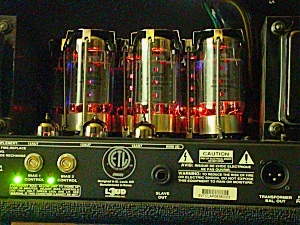|
To understand the reason for the guidelines, recall how a vacuum tube
works.
Every tube has at least two elements that conduct
electrons. The cathode emits electrons and the
anode (a.k.a. plate) collects them.
The tube's cathode is heated to such a high temperature that electrons in its coating, often an alkaline earth-metal oxide,
gain enough energy to break away from the coating.

This thermionic emission produces a red glow. Eventually, a cloud of electrons (negative charge)
builds up
in the space around the cathode. At that point, the tube is standing
by, ready to go to work.
When you exit Standby mode, you're applying a
relatively positive
voltage
(sometimes called B+) to the tube plates.
The positive anode attracts the negative electrons that surround the cathode.
The resulting
current powers your amp's circuitry. Electrons continuously circle
back to replace those that escaped the cathode's coating.
|